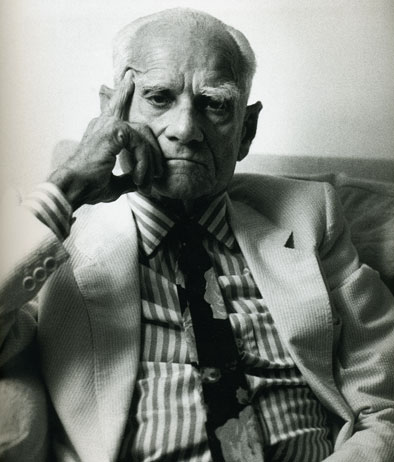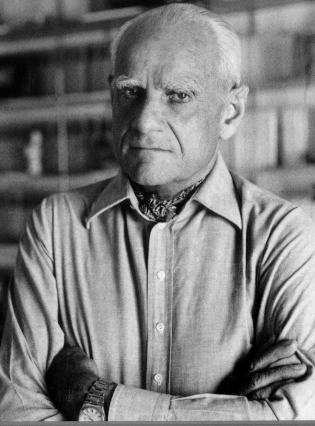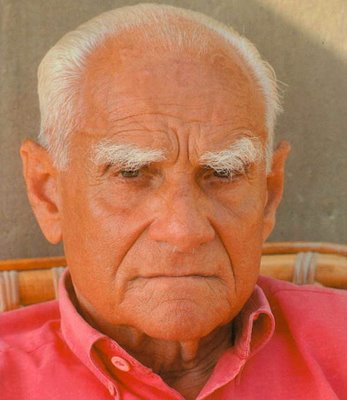<Back to Index>
- Philosopher Victor Cousin, 1792
- Novelist Alberto Pincherle (Moravia), 1907
- President of Argentina Arturo Frondizi Ercoli, 1908
PAGE SPONSOR
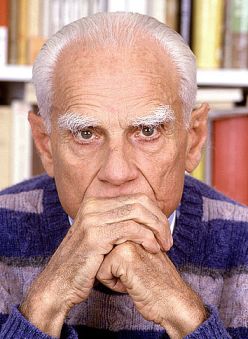
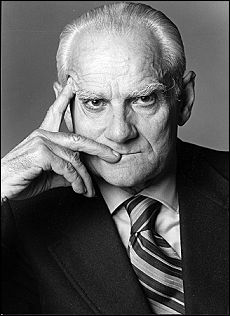
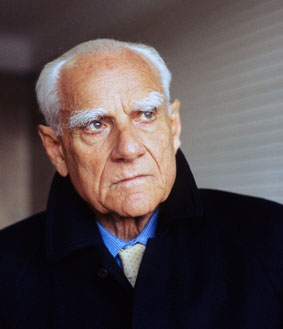
Alberto Moravia, born Alberto Pincherle (November 28, 1907 – September 26, 1990) was an Italian novelist. His novels explored matters of modern sexuality, social alienation, and existentialism.
He is best known for his debut novel Gli indifferenti (published in 1929), and for the anti - fascist novel Il Conformista (The Conformist), the basis for the film The Conformist (1970) by Bernardo Bertolucci. Other novels of his translated to the cinema are Il Disprezzo (A Ghost at Noon or Contempt) filmed by Jean - Luc Godard as Le Mépris (Contempt) (1963); La Noia (Boredom), filmed with that title by Damiano Damiani in 1963 and released in the US as The Empty Canvas in 1964; and La Ciociara filmed by Vittorio de Sica as Two Women (1960). Cedric Kahn's L'Ennui (1998) is another version of La Noia. Alberto
Pincherle (the pen name "Moravia" is the surname of his maternal
grandfather) was born on Via Sgambati in Rome, Italy, to a wealthy
middle class family. His Jewish father, Carlo, was an architect and a
painter. His Catholic mother, Teresa Iginia de Marsanich, was from Ancona, but of Dalmatian origin. Her brother Augusto De Marsanich, Moravia's uncle, was an undersecretary in the National Fascist Party cabinet. Moravia did not finish conventional schooling because, at the age of nine, he contracted tuberculosis of the bone that confined him to bed for five years. He spent three years at home, and two in a sanatorium at Cortina d'Ampezzo, in northeastern Italy. Moravia was an intelligent boy and devoted
himself to reading books: some of his favourite authors included Dostoevsky, Joyce, Ariosto, Goldoni, Shakespeare, Molière, Mallarmé. He learned French and German, and wrote poems in both languages. In 1925 he left the sanatorium and moved to Brixen, where he wrote his first novel, Gli Indifferenti (Time of Indifference),
published in 1929. The novel is a realistic analysis of the moral
decadence of a middle class mother and two of her children. In 1927,
Moravia met Corrado Alvaro and Massimo Bontempelli, and started his career as a journalist with the magazine 900,
which published his first short stories, including "La Cortigiana
Stanca" ("The Tired Courtesan" or in French as "Lassitude de
Courtisane", 1927), "Delitto al Circolo del Tennis" ("Crime at the
Tennis Club") (1928), "Il Ladro Curioso" ("The Curious Thief") and
"Apparizione" ("Apparition") (both 1929). Gli Indifferenti was published at his own expense of 5,000 Italian lira. Literary critics welcomed the novel as a noteworthy example of contemporary Italian narrative fiction. The next year, he started collaborating with the newspaper La Stampa, then edited by author Curzio Malaparte. In 1933, together with Mario Pannunzio, he founded the literary review magazines Caratteri ("Characters") and Oggi ("Today"), and started writing for the newspaper, La Gazzetta del Popolo. The years leading to World War II were problematic; the Fascist regime seized La Mascherata ("Masquerade") (1941), prohibited reviews of Le Ambizioni Sbagliate (1935), and banned publication of Agostino (Two Adolescents) (1941). In 1935 he traveled to the United States to give a lecture series on Italian literature. L'imbroglio ("The Cheat") was published by Bompiani in 1937. To avoid Fascist censorship he wrote mainly in the surrealist and allegoric genres, among the works is Il Sogno del Pigro ("The Dream of the Lazy"), however, the Fascist seizing of the second edition of La Mascherata, in 1941, thereafter forced him to write under a pseudonym. That same year, he married the novelist Elsa Morante, whom he had met in 1936; they lived in Capri, where he wrote Agostino. After the Armistice of 8 September 1943, Moravia and Morante took refuge in Fondi, on the border of Ciociaria; the experience inspired La Ciociara ("The Woman of Ciociara") (1958). In
May 1944, after the liberation of Rome, Alberto Moravia returned and
began collaborating with Corrado Alvaro, writing for important
newspapers such as Il Mondo and Il Corriere della Sera; the latter published his writing until his death. At war's end, his popularity steadily increased, with works such as La Romana (The Woman of Rome) (1947), La Disubbidienza (Disobedience) (1948), L'Amore Coniugale e altri racconti ("Conjugal Love and other stories") (1949) and Il Conformista ("The Conformist") (1951). In 1952 he won the Premio Strega for I Racconti, and his novels began to be translated abroad. That same year "La Provinciale" was cinematically adapted by Mario Soldati; in 1954 Luigi Zampa directed La Romana, and in 1955 Gianni Franciolini directed I Racconti Romani ("The Roman Stories") (1954) a short collection that won the Marzotto Award. In 1953, Moravia founded the literary magazine Nuovi Argomenti ("New Arguments"), which featured Pier Paolo Pasolini among its editors. In the 1950s, he wrote prefaces to works such as Belli's 100 Sonnets, Brancati's Paolo il Caldo and Stendhal's Roman Walks. From 1957 onwards, he also reviewed and criticised cinema for the weekly magazines L'Europeo and L'Espresso; it is collected in the volume Al Cinema ("At the Cinema") (1975). In 1960, he published one of his most famous novels, La Noia (Boredom or The Empty Canvas),
the story of the troubled sexual relationship between a young, rich
painter striving to find sense in his life and an easygoing girl, in
Rome. It won the Viareggio Prize and was filmed by Damiano Damiani in 1962. An adaptation of the book is the basis of Cedric Kahn's film L'ennui ("The Ennui") (1998). Several films were based on his other novels: in 1960, Vittorio De Sica cinematically adapted La Ciociara with Sophia Loren; in 1963 Jean - Luc Godard filmed Il Disprezzo (Contempt) ; in 1964 Francesco Maselli filmed Gli Indifferenti (1964). In 1962 Moravia and Elsa Morante parted; he went to live with the young writer Dacia Maraini. Increasingly, he concentrated on theatre; in 1966, he and Maraini and Enzo Siciliano founded the company called "Il Porcospino", which staged works by Moravia, Maraini, Carlo Emilio Gadda, and others. In 1967 Moravia visited China, Japan, and Korea. In 1971 he published the novel Io e lui (["I and He"] The Two of Us) about a screenwriter and his independent penis and the situations to which he thrusts them, and the essay Poesia e romanzo ("Poetry and Novel"). In 1972 he went to Africa, which inspired his work A quale tribù appartieni? ("Which Tribe Do You Belong To?"), published in the same year. His 1982 trip to Japan, including a visit to Hiroshima, inspired a series of articles for L'Espresso magazine about the atomic bomb. The same theme is in the novel L'Uomo che Guarda ("The Man Who Looks") (1985) and the essay L'Inverno Nucleare ("The Nuclear Winter") including interviews with some contemporary principal scientists and politicians. The short story collection, La Cosa e altri racconti ("The
Thing and other stories"), was dedicated to Carmen Llera, his new
companion (forty - five years his junior), whom he married in 1986. In
1984 he was elected to the European Parliament as member from the Italian Communist Party. His experiences at Strasbourg, which ended in 1988, are told in Il Diario Europeo ("The European Diary"). In 1985 he won the title of "European Personality". In September 1990, Alberto Moravia was found dead in the bathroom of his Lungotevere apartment, in Rome. In that year, Bompani published his autobiography, Vita di Moravia ("Life of Moravia"). Moral
aridity, the hypocrisy of contemporary life, and the substantial
incapability of people finding happiness in traditional ways such as
love and marriage are the regnant themes in the works of Alberto
Moravia. Usually, these conditions are pathologically typical of
middle class life; marriage, in particular, is the target of works such
as Disobedience and L'amore coniugale ("The Conjugal Love") (1949). Alienation is the theme in works such as Il disprezzo ("Contempt" or "A Ghost at Noon") (1954) and La noia ("The
Empty Canvas"), from the 1950s, despite observation from a
rational realistic perspective. Political themes are often present: an
example is La Romana ("The
Woman of Rome") (1947), the story of a prostitute entangled with the
Fascist regime and with a network of conspirators. The extreme sexual
realism in La noia ("The Empty Canvas") (1960), introduced the psychologically experimental works of the 1970s. Moravia's
writing style was highly regarded for being extremely stark and
unadorned, characterised by very elementary, common words within an
elaborate syntax. A complex mood is established by mixing a proposition
constituting the description of a single psychological observation
mixed with another such proposition. In the later novels, the inner
monologue is prominent.
